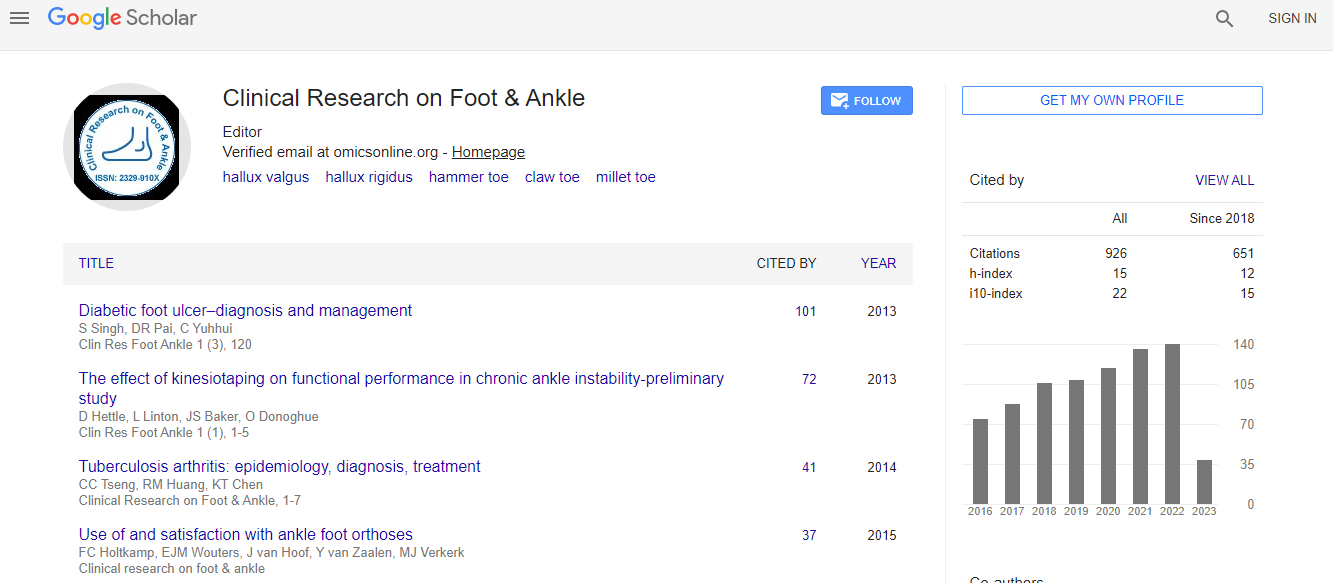Case Report
Transcuneiform Crush Injury: A Case Report
| Laksha Dutt*, Susan Fisher, David J. Wilson and Paul Ryan | ||
| Orthopaedic Surgery, Madigan Army Medical Center (MAMC), Tacoma, Washington, USA | ||
| Corresponding Author : | Laksha Dutt Madigan Army Medical Center Orthopaedic Surgery, 9040 Fitzsimmons Ave tacoma, wa 98431, United States Tel: 510-557-5943 E-mail: laksha.dutt.mil@mail.mil |
|
| Received December 15, 2014; Accepted December 27, 2014; Published January 02, 2015 | ||
| Citation: Dutt L, Fisher S, Wilson DJ, Ryan P (2015) Transcuneiform Crush Injury: A Case Report. Clin Res Foot Ankle 3:162. doi:10.4172/2329-910X.1000162 | ||
| Copyright: ©2015 Dutt L, et al. This is an open-access article distributed under the terms of the Creative Commons Attribution License, which permits unrestricted use, distribution, and reproduction in any medium, provided the original author and source are credited. | ||
Related article at Pubmed Pubmed  Scholar Google Scholar Google |
||
Abstract
Introduction: Transcuneiform fracture patterns without dislocations are uncommon. In a review of the literature, numerous case reports describe cuneiform fracture-dislocations involving either the transmetatarsal or midtarsal joint complexes due to direct trauma; however, an isolated transcuneiform fracture pattern without dislocation has not been reported.
Methods: We present a rare injury of the foot: an isolated transcuneiform fracture without associated dislocation of the tarsometatarsal joint or midtarsal joint complex.
Case: A 29 year old active duty Army male sustained direct blunt trauma to his foot when a 20 ton trailer fell onto it. His initial presentation prompted protected weight bearing after a clinical exam revealed soft tissue injury and tenderness to palpation about the dorsum of his midfoot. Due to persistent symptoms, he was referred to a musculoskeletal specialist. Radiographs and computed tomography (CT) images demonstrated a minimally displaced comminuted transcuneiform fracture involving the medial and intermediate cuneiforms without evidence of dislocation or subluxation. Treatment consisted of non-weight bearing cast immobilization with crutches for ten weeks before being transitioned into a weight bearing control ankle motion (CAM) boot. Radiographic evidence of healing was documented at 4 weeks by callus formation at the first metatarsal and medial cuneiform. The patient returned to low impact activity by 10 month follow-up without surgical intervention.
Discussion and Conclusions: Blunt trauma to the midfoot can result in isolated or complex fracture patterns without the typical fracture-dislocation following high mechanism trauma. Appropriate clinical suspicion and careful physical examination can facilitate timely diagnosis and treatment. Minimally displaced transcuneifom fracture patterns without associated midfoot dislocation injuries can be treated nonoperatively with protected weight bearing, close radiographic and clinical follow up, and gradual advancement to activity with acceptable clinical outcomes.

 Spanish
Spanish  Chinese
Chinese  Russian
Russian  German
German  French
French  Japanese
Japanese  Portuguese
Portuguese  Hindi
Hindi 
